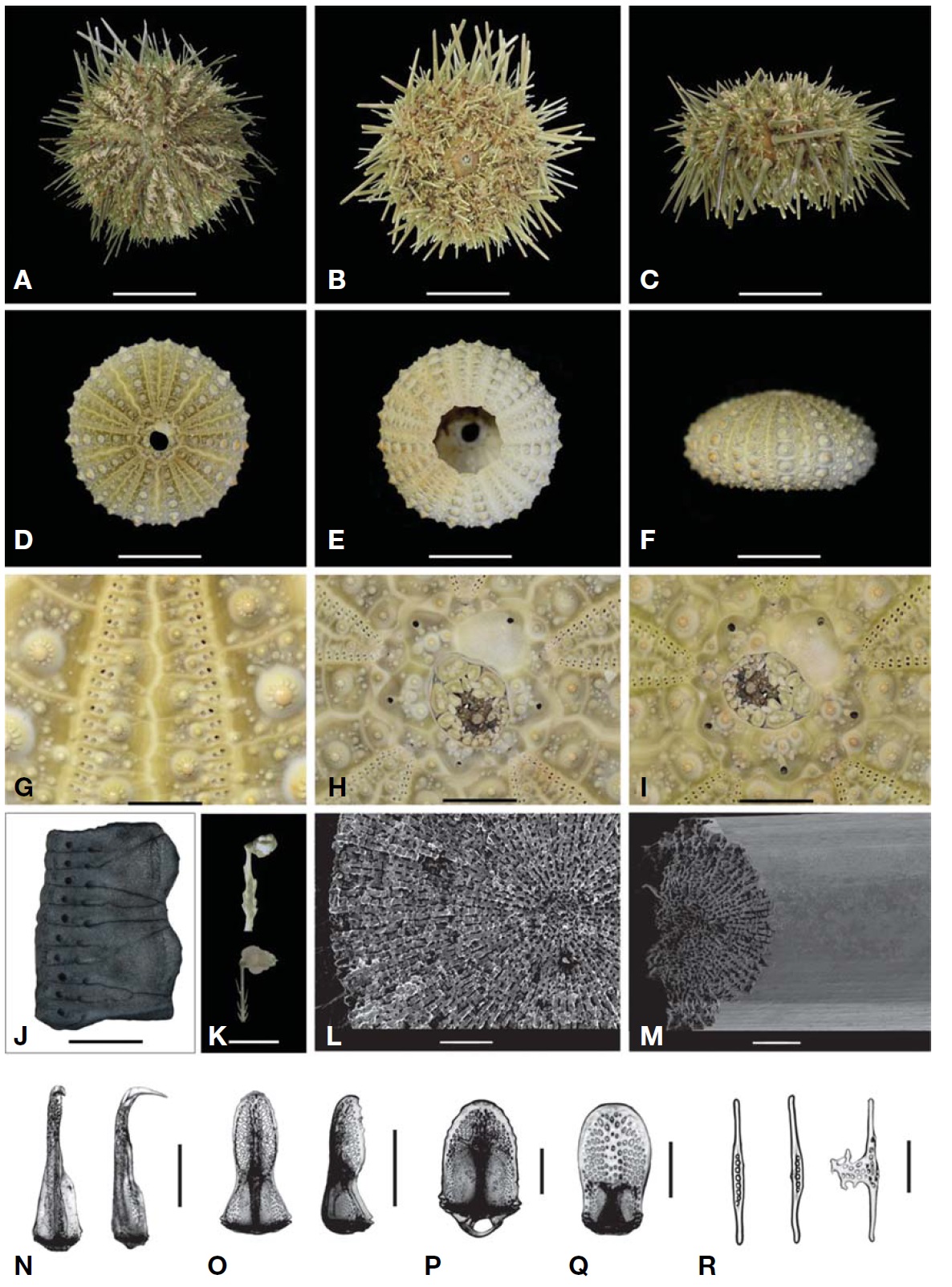



Sea urchins are familiar marine benthic species which are classified into two subclasses: Cidaroidea and Euechinoidea. Euechinoidea includes 11 orders (Kroh and Mooi, 2013). Of them, the order Stomopneustoida comprises only two species of two families:
Sea urchins were collected from adjacent waters of Daludo Island and Mohang harbor of the Yellow Sea between June 2008 and June 2012. These were preserved in above 95% ethyl alcohol and their important morphological characters were photographed using a digital camera (D7000; Nikon, Tokyo, Japan), stereo- and light-microscopes (Nikon SMZ 1000; Nikon Eclipse 80
Class Echinoidea Leske, 1778
Subclass Euechinoidea Bronn, 1860
Key to the orders of subclass Euechinoidea in Korea
1. Periproct located in apical system ?????????????????????????????? 2
- Periproct not located in apical system ???????????????????????? 5
2. Teeth with grooved inner surface ???????????? Diadematoida
- Teeth with keeled inner surface ????????????????????????????????? 3
3. Epiphyses joining over teeth ???????????????????? Camarodonta
- Epiphyses not joining over teeth ???????????????????????????????? 4
4. Amburacral plate consisting of a primary plate and two demi-plates ???????????????????????????????????????????????? Arbacioida
- Amburacral plate consisting of three primary plates and two demi-plates ???????????????????????????????? Stomopneustoida
5. Test of discoid shape, with dental apparatus ??????????????????????????????????????????????????????????????????????????????? Clypeasteroida
- Test of heart shape, without dental apparatus ?????????????????????????????????????????????????????????????????????????????????? Spatangoida
1*Order Stomopneustoida Kroh and Smith, 2010
Stomopneustoida Kroh and Smith, 2010: 170; Kroh and Mooi, 2013: 510530.
2*Family Glyptocidaridae Jensen, 1982
Glyptocidaridae Jensen, 1982: 90; Kroh and Mooi, 2013: 510741.
3*Genus Glyptocidaris A. Agassiz, 1864
Glyptocidaris A Agassiz, 1864: 356; HL Clark, 1912: 228; Mortensen, 1935: 480; D’yakonov, 1969: 170; Kroh and Mooi, 2013: 512516.
Type species: Glyptocidaris crenularis A. Agassiz, 1864.
4*Glyptocidaris crenularis A. Agassiz, 1864 (Fig. 1)
Glyptocidaris crenularis A Agassiz, 1864: 356; Doderlein, 1906: 520; HL Clark, 1912: 228; Mortensen, 1935: 480; Utinomi, 1960: 339; D’yakonov, 1969: 170; Kroh and Mooi, 2013: 513284.
Material examined. 1 specimen by SCUBA diving, Daludo Island, 1 Jun 2008; 3 dried specimens by fish trap, Mohang harbor, 11 Aug 2010; 4 dried specimens by fish trap, Mohang, 4 Sep 2011; 8 specimens by fish trap, Mohang, 3 Jun 2012; 37 specimens by fish trap, Mohang, 24 Jun 2012.
Description. Test moderately sized, slightly flattened or low hemispherical form, rather roundly pentagonal outline, with distinctly flattened ventral side (Fig. 1A-F). Ambulacrum nearly half as broad as interambulacrum (Fig. 1F). Narrow median lines on ambulacral and interambulacral rows remain bare from apical system almost to ambitus. Ambulacral porepairs usually five in number, arranged in a slightly horizontal row closer to apical system on dorsal side but towards ventral side begin to curved-oblique alternating rows (Fig. 1D, E). Pore zone on ventral side not wide near peristome (Fig. 1E). Ambulacral plates with five elements composing three primary plates and two demi-plates (Fig. 1J). All primary tubercles distinctly and deeply crenulated, rapidly decreasing in size towards apical system on dorsal side. Large secondary tubercles in adambulacral plates also crenulated, but other small ones on ambulacral and adambulacral plates not crenulated (Fig. 1G). Apical system broad, periproct consisting of miliary plates with tubercles. Genital and ocular plates covered with slightly crenulated or non-crenulated small tubercles. Genital plates uniform in width and roundly pentagonal (Fig. 1H, I). I ocular plate (Fig. 1H) or IV ocular plate (Fig. 1I) inserted between borders of genital plates and reaching periproct (Fig. 1H, I, respectively). Primary spines smooth, long, gradually tapered to tips (Fig. 1L, M), longest ones on ambitus reaching almost 75% length of test diameter, but rapidly decreased towards apical system. Secondary spines short, stout, thorny, and miliary spines very small. Globiferous, tridentate, ophiocephalous and triphyllous pedicellariae present (Fig. 1N-Q). Globiferous pedicellariae numerous, each valve with long stalk equipped with one to six, but usually four to six, long lateral processes covering membranes, resembling fins (Fig. 1K), or more rarely with short stalk without process, and with a well-developed long sharp terminal hook (Fig. 1N). Tridentate pedicellariae rare, variable in length, with porous paddle formed valves with slightly serrated distal parts (Fig. 1O). Ophiocephalous pedicellariae numerous on ventral side, oval shaped, with short broad thimble formed valves with slightly serrated distal parts (Fig. 1P). Triphyllous pedicellariae small, with slightly elongated valve with round distal part (Fig. 1Q). Spicules of tube feet straight or irregular bar shaped, with porous center, and with blunt tips (Fig. 1R).
Size. Test diameter ???????????????????????????????????48.2-68.5 mm
Test height ??44.6-45.0% of test diameter ??21.5-30.7mm
Peristome ????35.2-35.8% of test diameter ??17.1-24.5mm
Color. Test and spines are light olive or olive, but the base of spine is dark violet.
Distribution. Korea (Yellow Sea), Japan (Tsugaru Strait, Mutsu Bay, Kinkasan, Sado Island), China (Dailian).
Remarks.
Island and Mohang harbor, in this study). Further surveying is required in order to establish the true extent of this species which has not yet been observed in the East Sea of Korea and the Korea Strait.
Korean name: 1*기공성게목(신칭), 2*조각관성게과(신칭), 3*조각관성게속(신칭), 4*조각관성게(신칭)
